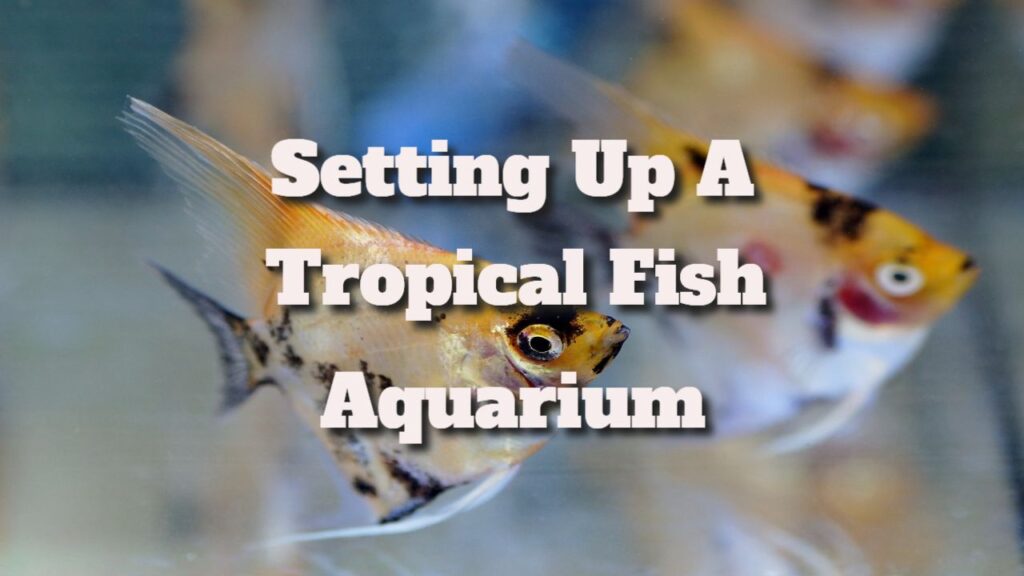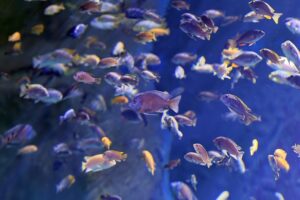How To Set Up A Tropical Fish Aquarium
How To Set Up A Tropical Fish Aquarium: Are you starting with tropical fish for the first time? Here’s our step-by-step guide to getting started.
Aquarium with fish
Of course, an aquarium is required, but they are available in various shapes and sizes to suit all interests.
While choosing a unique shape is enticing, a normal rectangle is recommended for the following reasons:
It has a high surface-to-volume ratio. This allows oxygen to permeate the water and CO2 to disperse at night.
Because of the surface area and oxygen supply, a large surface area tank may house more freshwater fish than a small surface area tank.
Many fish, such as cichlids and catfish, require space to swim and move about and a substrate area to feed and breed.
Buying the largest aquarium, you can afford is not a sales tactic.
Larger water volumes are more temperature and water quality stable than small tanks, allowing you to keep a far wider variety of fish species in greater numbers.
Because many small tropical fish school, a communal tank must be large enough to support schools of fish.
Most aquarium species require large tanks, including a school of six or more tetras, three or more armoured catfish, six or more rasboras, five or more guppies, and the best algae eaters like bristlenose catfish.
Aquariums with a volume of 54 litres and a length of 60 cm or more are ideal for beginners who want to manage a community of 15-20 small tropical fish or a few small coldwater fish.
Your fish variety expands significantly if you choose an aquarium with 180 litres or more volume and a length of 90 cm or more. It includes popular species like angelfish and rainbowfish, as well as a community of 30 or more small to medium-sized fish that vary in size, colour, and commotion, and they desire to use every floor of their new home.
Aquarium Storage Cabinet
The manufacturer’s warranty may be voided if a heavy, water-filled aquarium is placed on unsuitable house furniture.
In the worst-case scenario, the furniture could collapse beneath it. Instead, choose a cabinet specifically designed to hold the aquarium’s weight for your make and model.
Cabinets are also helpful for aquariums in other ways, such as hiding external power filters, which are the ideal filtration choice for a tropical or cold-water freshwater aquarium, as well as food pots, test kits, and all those plugs and cords.
Aquarium heaters
Tropical fish are found in tropical regions such as South America, Southeast Asia, and Africa, where the weather is hot all year, and water temperatures rarely fall below 24 degrees Celsius.
A heater features a thermostat that may be set to 24 degrees Celsius and kept there all year, allowing your fish to develop accustomed to tropical temperatures.
Some new heaters can show the temperature of the aquarium water and tell if it is too hot or too cold. Nonetheless, every aquarium owner should keep a thermometer to check the temperature swiftly.
If you’re unsure what size heater you need, choose one with the same or higher wattage as your aquarium.
For a 100-gallon tank, a 100-watt heater is required. A 200-watt heater, for example, for a 200-litre tank.
Because heaters are only available in a few capacities, often up to 300 watts, if you had a 180-litre tank, you would choose the next higher heater type at 200 watts.
Two heaters, one 200-watt and one 300-watt, are required for a sizeable 500-litre tank.
Aquarium filtration
Every aquarium needs a filter since it functions as the fish’s life support system. Filtration systems are critical components of any aquarium setup and should run continuously.
Filters, like aquariums, come in various shapes and sizes to fit each aquarium, and their pricing and performance vary.
Internal filters are popular among novices since they are easy to install and give good effects.
If you’re starting with a large aquarium and want to provide the finest possible environment for your fish, an external flow filter is a way to go.
When choosing the filter for your tank, models are advised for different tank lengths or water volumes. Choose “2” for a two-foot-long tank or a filter for a 200-gallon tank if your tank holds between 100 and 200 gallons.
As with heaters, consider the next size up if your tank is an intermediate size, such as 180 gallons.
If you want to keep cichlids or goldfish, you may need twice the amount of filter material, which could mean two units.
Aquarium illumination
Consider a tropical fish aquarium full of movement and colour, with lighting to help bring it all to life.
Many aquariums already have integrated lighting. However, the bulbs can usually be swapped out for better plant growth or fish colour or replaced with stronger lights.
For open tanks, separate lighting and tank mounts are necessary, and some lights can also be controlled by a separate controller or an app on a smartphone or tablet.
Plants require 8-10 hours of steady lighting per day. When they are not visible, fish can switch off their lights.
If the lighting cannot be controlled, a simple timer should be employed, as leaving the aquarium lighting on for 12 hours or more every day will result in algae.
Use one-of-a-kind marine lights in saltwater aquariums.
Air pumps for aquaculture
Air pumps are an optional addition with considerable value when constructing a tropical aquarium.
An airline and an air stone are used in air pumps to blow air into the water, where the bubbles distribute oxygen, which is necessary for fish.
Air pumps create oxygen more accurately than filters that spin the water surface, which is especially useful in congested tanks with huge fish.
If you run an air pump and a separate filter, the fish will still have access to oxygen if the filter fails, protecting their life until you notice and repair the filter problem.
Ammonia and nitrite are present in the water when medications are taken, and beneficial filter bacteria are aerobic, consuming and utilising oxygen. Aeration is advised.
Air bubbles rising through the aquarium water can be relaxing, and certain ornaments can be air-powered, animating and entertaining children. The fish are unconcerned as well!
A check valve is an essential part of all air pumps.
Air pumps in a cabinet beneath the aquarium might pull in aquarium water instead of pumping out the air during a power outage. A check valve prevents this, as well as puddling and damage to the air pump.
Aquarium decoration
Decoration helps fish feel more at peace in their bare glass enclosures while allowing the owner to express their creativity.
Make a gravel layer 5 inches deep in the front and 7.5 inches deep in the back to attach plastic plants or natural root plants.
Gravel is available in various natural and vibrant artificial colours and grades ranging from coarse to fine sand.
Before adding gravel to the tank, it should be thoroughly cleaned in a clean bucket by hand.
Popular decorative items include stones, ornaments, and bogwood. However, ensure the wood you use is aquarium-safe, as some float and can leach toxic compounds into the tank water.
Bogwood will seep brown tannins into the water after being in the aquarium for several months.
This is an entirely natural phenomenon. Many tropical fish, such as cardinal tetras, live in tea-coloured “black water” in the Amazon and benefit from tannin-coloured water.
If you don’t like this and want crystal clear water, fill the filter with activated carbon and change it regularly. After the gravel, add stones, wood, and ornaments.
How does one go about filling an aquarium?
Tropical aquariums can initially be filled with tap water, but there are a few procedures to follow to ensure the water is safe for tropical fish.
A de-chlorinator is the first and most crucial component. By neutralising chlorine, this simple liquid disinfects tap water and filters bacteria.
If in doubt, use a de-chlorinator that neutralises both and use it whenever you fill the tank with tap water or add tap water during a water change.
After dechlorination, beneficial bacteria might be added. New biological filters should be activated to transform harmful fish waste into less toxic chemicals.
Your aquarium should be at the proper temperature within 24 hours.
Dechlorinators start working immediately, but avoiding “New Tank Syndrome,” a new tank should be carefully stocked with a few hardy fish for the first few days and weeks.
Aquarium testing supplies
You’ll need test kits if you keep fish in an aquarium.
Aquarium water can be crystal clear but poisonous, and the only way to know if it is safe to keep fish in is to use test kits.
A new aquarium necessitates using four test kits: pH, ammonia, nitrite, and nitrate.
These allow you to monitor water quality in new and mature aquariums and build an early warning system if it deteriorates.
As the tank grows, test daily to see if dangerous ammonia and nitrite levels climb and then begin to decline. Monthly monitoring is recommended once the tank has been fully established.
Other aquarium requirements
Everyone who owns an aquarium should keep a fish net on hand because you never know when you’ll need one.
Difficult-to-catch species, such as fast-swimming beautiful carp, are best caught with two nets, one in front and one behind them.
You’ll also need an algae pad or magnet to regularly remove green algae growth from the front glass, as well as a syphon tube to retrieve water for water changes.
These simple but powerful tubes suck dirt out of the gravel while removing water.
Prepare a range of dry and frozen food for the fish, which swim at various levels and have distinct nutritional needs.
The post How To Set Up A Tropical Fish Aquarium appeared first on https://gqcentral.co.uk










Comments are closed